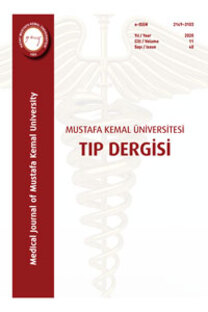Ümit Halıcı, Mehmet Kayğın, Özgür Dağ, Hüsnü Limandal, Ümit Arslan, Adem Kıymaz, Ahmet Aydın, Bilgehan Erkut
GEÇİCİ HEMODİYALİZ KATETER UYGULAMALARIMIZ
Amaç: Bu çalışmada, geçici hemodiyalizkateter girişimleri ve bunlarla ilişkilikomplikasyonları incelemeyi amaçladık.Hastalar ve Yöntem: Kliniğimizde Ocak2006- Mayıs 2013 tarihleri arasındahemodiyaliz amaçlı bir ve/veya birden çoksayıda geçici kateter takılan 782 hasta (488erkek, 294 kadın, yaşları 11-91 arasında,ortalama yaş; 47±13), retrospektif olarakincelendi. 484 hastaya bir, 158 hastaya iki, 103hastaya üç, 30 hastaya dört, 7 hastaya beş kezkateter yerleştirildi. 192 hastada böbrekyetmezliği tanısı yeni konulmuştu. 254 hastaise kronik böbrek yetmezliği hastası olup dahaönceden diyalize giren hastalardı.Hastalarımızın 486’sına sağ internal jugulervene (İJV), 173’üne sol İJV, 98’ıne femoralvene, 25’ine subklaviyan vene kateteryerleştirildi.Bulgular: Hemodiyaliz kateterine bağlı olarakgörülen en sık komplikasyon kateterdisfonksiyonu idi. Dört hastamızda karotisarter ponksiyonuna bağlı hematom gelişti.Hastalarımızda hemotoraks ve/veyapnömotoraks komplikasyonu gözlenmedi.Hastalarımızın 98’ıne femoral ven yoluylageçici kateter yerleştirildi. Bu femoralkateterlerden 22 ‘si kateterdeki bükülme vetıkanma nedeniyle ortalama dördüncü günde,27’si ise enfeksiyon nedeniyle ortalama8.günde çıkarıldı. Erken komplikasyon olarak4 hastada boyunda hematom, 87 hastadakateter disfonksiyonu gelişti. Geçkomplikasyon 59 hastada gelişti.Sonuç: Geçici hemodiyaliz kateteruygulamalarında en sık görülen sorun kateterdisfonksiyonudur. Kateterlerin deneyimlikişiler tarafından takılması ile işlem başarısınınartacağı ve komplikasyon oranlarınınazaltacağı kanatindeyiz.Anahtar kelimeler: Hemodiyaliz, Geçicihemodiyaliz kateteri, Kronik böbrekyetmezliği
Anahtar Kelimeler:
Hemodiyaliz, Geçici hemodiyaliz kateteri, Kronik böbrek yetmezliği
Our Temporary Hemodialysis Catheter Applications
Aim: We aimed investigation of temporaryhemodialysis catheter applications and itscomplications in this study.Patients and Methods: We retrospectivelyevaluated 782 patients(488 men, 294 women,in age range between 11-91, mean age; 47±13years) which were underwent one and/or moretimes catheter applications for hemodialysis inour clinic between October 2006-May 2013.484 patients, 158 patients, 103 patients, 30patients and 7 patients underwent to catheterplacement once, twice, thrice, four times andfive times respectively. 192 patients werediagnosed new acute renal failure and 254patients had been diagnosed chronic renalfailure and they had been underwenthemodialysis. Locations of application ofcathateters are right internal jugular vein(IJV),left IJV, femoral vein, subclavian vein in 486,173, 98 and 25 patients respectively.Results: The most frequent early termcomplication of hemodialysis catheters wascatheter dysfunction. Hematoma due to carotidartery puncture were observed in 4 patients.Hemothorax or pneumothorax was not seen.Femoral vein catheters were placed in 98patients. 49 of them were removed because ofcatheter fraction and occlusion in 22 patientson mean day 4 th day and catheter infection in27 patients on mean 8 th day after intervention.Neck hematoma and catheter dysfunction wereseen in in 4 patients in 87 patients, repectivelyas early term complications. Late termcomplications of hemodialysis catheters wereseen in 59 patients and catheter occlusionConclusion: The most common problem oftemporary hemodialysis catheheterapplications is catheter dysfunction. Catheterplacement must be performed by trainedpersons for augmentation of success ofintervention and diminition of complications.
___
- Gentile AT, Berman SS. Short- and long-term hemodialysis catheters. In: Berman SS,
- ed. Vascular Access In Clinical Practice. USA: Marcel Dekker, 2002: 179-92.
- Albers F. Causes of hemodialysis Access failure. Adv Ren Replace Ther 1994; 1: 107-
- -
- Atherikul K, Schwab SJ, Twardowski ZJ, et al. What is the role of permanent central
- vein Access in hemodialysis patients? Semin Dial 1996; 9: 392-403.
- Atherikul K, Schwab SJ, Conlon PJ. Adequacy of hemodialysis with cuffed centralvein
- catheters. Nephrol Dial Transplant 1998; 13: 745-9.
- Akoh JA. Central venous catheters. In: Akoh JA, Hakim NS, editors. Dialysis access
- current practice.1st ed. London: Imperial College Press, 2001: 257-302.
- Mickley V. Central venous catheters: many questions, few answers. Nephrol Dial
- Transplant 2002; 17: 1368-73.
- Oguzkurt L, Tercan F, Torun D, Yıldırım T, Zümrütdal A, Kızılkılıc O. Impact of
- short- term hemodialysis catheters on the central veins: a catheter venographic study.
- Eur. J. Radiol 2004; 52: 293-9.
- Karakaya D, Barış S, Güldogus F, Incesu L, Sarıhasan B, Tür A. Brachial plexus
- injury during subclavian vein catheterization for hemodialysis. J Clin Anesth 2000; 12:
- -3.
- Halıcı U, Duran E, Canbaz S. Hemodiyaliz kateterleri ve kateterizasyon teknikleri.
- Trakya Üniversitesi Tıp Fakültesi Dergisi 2004; 21: 23-30.
- National Kidney Fondation-Dialysis Outcomes Quality Initiative. In: Schwab S,
- Besarab A, Beathard G, et al. (eds). NKF-DOQI Clinical Practice Guidelines for
- Vascular Access. New York:National Kidney Foundation, 1997.
- Kurt N, Gürel A, Erel V, Karaman C, Taşkın F. Açık kalp cerrahisinde internal juguler
- ven kateterizasyonuna bağlı trombüs insidansını etkileyen faktörler. Anestezi Dergisi
- ; 11:283-9. 7.
- Gentile AT, Berman SS. Short- and long-term hemodialysis catheters. In: Berman SS,
- ed.Vascular Access In Clinical Practice. USA: Marcel Dekker, 2002: 179-192.
- Marek JM, Berman SS. Catheter related complications: their prophylaxis and
- management. In: Berman SS, (eds) Vascular Access In Clinical Practice. USA: Marcel
- Dekker, 2002: 337-71.
- Zaleski GX, Funaki B, Lorenz JM, Garafalo RS, Moscatel MA, Rosenblum JD, Leef
- JA: Experience with tunneled femoral hemodialysis catheters. Am J Roentgenol 1999;
- : 493-6.
- Mathur MN, Storey DW, White GH, Ramsey-Stewart G: Percutaneous insertion of
- long-term venous access catheters via the external iliac vein. Aust NZ J Surg 1993; 63:
- -63.
- Lugo LJ, Zapata NJ, Ramirez Ronda CH. Catheter related infections in Damas
- Hospital. Bol Asoc Med PR. 1994; 86: 37-41.
- Atherikul K, Schwab SJ, Conlon PJ. Adequacy of hemodialysis with cuffed centralvein
- catheters. Nephrol Dial Transplant 1998;13:745-9.
- Robinson D, Suhocki P, Schwab SJ. Treatment of infected tunneled venous Access
- hemodialysis catheters with guıdewire exchange. Kidney Int 1998; 53: 1792-4.
- ISSN: 2149-3103
- Yayın Aralığı: Yılda 3 Sayı
- Başlangıç: 2010
- Yayıncı: Hatay Mustafa Kemal Üniversitesi Tıp Fakültesi Dekanlığı
Sayıdaki Diğer Makaleler
GEÇİCİ HEMODİYALİZ KATETER UYGULAMALARIMIZ
Ümit Halıcı, Mehmet Kayğın, Özgür Dağ, Hüsnü Limandal, Ümit Arslan, Adem Kıymaz, Ahmet Aydın, Bilgehan Erkut
Mustafa Özgür, Celalettin Dağlı, Fatma Ceylan, Harun Atıcı, Murat Karcıoğlu
ENSEFALOMALAZİK GÖRÜNÜMLÜ GLİABLASTOME MULTİFORME: OLGU SUNUMU
S. BAŞARSLAN, Cüneyt GÖÇMEZ, Abdülkerim GÖKOĞLU, Ahmet MENKÜ
Füsun AYDOĞAN, Erhan YENGİL, Nilgül ÜSTÜN, Raif ÖZDEN, Mehmet HELVACI
KLARİTROMİSİNE BAĞLI GELİŞEN AKUT PANKREATİT
M. ÇELİK, Mehmet DEMİR, Melda BULGURCU, Ali KARAKUŞ, Gamze KAVVASOĞLU
